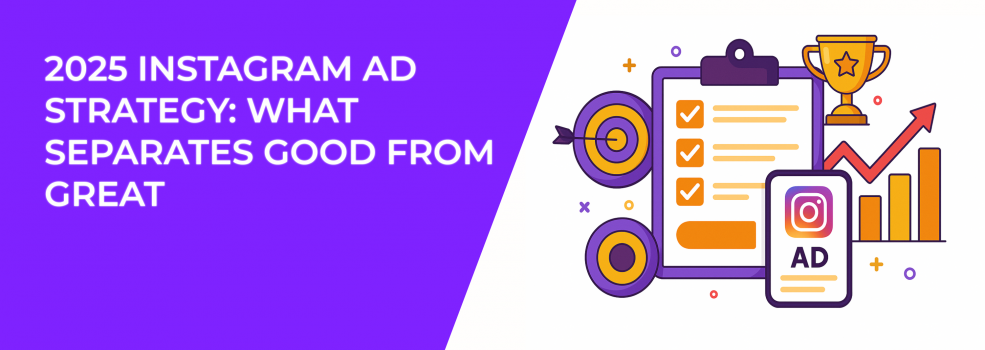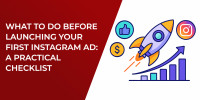Instagram ads in 2025 are more competitive than ever. But while many advertisers run campaigns, only a few get consistent, scalable results. What’s the difference?
A great Instagram ad strategy doesn’t rely on trends or guesswork — it’s built on data, behavior, and content that actually connects.
In this guide, we break down the key elements that separate good Instagram ads from great ones. Whether you're running your first campaign or optimizing your tenth, these tips will sharpen your strategy and improve your performance.
1. Know the Platform and How People Use It
Instagram is constantly evolving, but the way users behave hasn’t changed much. People still:
-
Scroll for quick inspiration,
-
Tap through Stories on autopilot,
-
Watch Reels with sound on,
-
Save content that feels useful, and
-
DM posts they want to share.
Great Instagram advertisers focus on these behaviors — not just on trends. The best campaigns feel like they belong on the platform while guiding users naturally toward the brand. That’s the real sweet spot.
Checking the patterns of how users interact with your ads (e.g. heatmaps) can help you make them more effective.
Actionable tip: audit your ad content from the user's point of view. Ask:
-
Would someone save this?
-
Does it feel native or obviously promotional?
-
Does it match the format people expect in that placement (Reel, Story, Feed)?
These questions help align your ads with real user behavior, not assumptions.
2. Design Creative That Feels Native But Stands Out
In 2025, creative is still king. But it’s not about looking perfect — it’s about capturing attention fast.
Good Instagram ads blend in. Great ones stop the scroll.
What works right now:
-
UGC-style videos over studio-polished content,
-
Motion and movement in the first 1–2 seconds,
-
Captions for sound-off viewing in Feed, and
-
Full-screen vertical videos (1080x1920) for Stories and Reels.
These formats not only perform better — they also feel authentic, which is key to engaging users who are increasingly skeptical of polished, salesy content.
Start your video ads with:
-
A bold statement or surprising question,
-
Quick cuts and motion in the first second, and
-
A face, voice, or real person talking directly to the camera.
This helps your ad feel like content, and that makes all the difference.
If you're using Reels in your Instagram campaigns, make sure you're applying the latest best practices from this guide to using Instagram Reels in your marketing strategy.
3. Embrace Smart Targeting Instead of Over-Segmentation
Meta’s algorithm is doing more of the heavy lifting in 2025. Narrow interest targeting is less reliable. Instead, performance depends on your signals, audience quality, and creative relevance.
What great advertisers do:
-
Use broad targeting with strong creative,
-
Build Custom Audiences from CRM data, site traffic, or engagement,
-
Retarget based on video views, saves, or profile visits, and
-
Create Lookalike Audiences based on actual conversions.
The key is feeding Meta’s systems with rich, accurate engagement data, not boxing yourself into tiny audiences that might miss the mark.
Create a custom audience from users who:
-
Saved your Instagram posts,
-
Engaged with your profile in the last 90 days, or
-
Watched 50% or more of your Reels.
Then, run Story ads with a clear CTA to guide those warm users toward conversion. It's a much smoother path than cold outreach alone.
4. Think in Funnels But Make It Flexible
The old “see ad, click link, buy” funnel is gone. In 2025, Instagram users take a winding path to purchase. They might watch a Reel, then Google your brand, then come back via a retargeted Story a week later.
Build a funnel that feels seamless:
-
Top-of-funnel (TOF): Reels or Carousels that educate or entertain,
-
Middle-of-funnel (MOF): Testimonials, how-tos, FAQs,
-
Bottom-of-funnel (BOF): Offers, urgency, product benefits.
Your funnel should reflect how people actually shop today — not how marketers wish they did.
Use Meta’s built-in retargeting tools to show:
-
Video watchers a product demo,
-
Profile visitors a limited-time offer, and
-
Abandoned cart users a testimonial ad with a discount.
This keeps your message consistent while adapting to how different users interact with your brand.
Choosing the right campaign objective is just as critical as funnel sequencing — and if you're unsure, this breakdown of Meta ad campaign objectives will help you align your goals with the right settings.
5. Measure the Right Metrics
Vanity metrics like likes and followers are easy to chase — but they don’t tell you much.
Great Instagram ad strategies focus on metrics that signal real intent and performance.
Focus on:
-
Saves — shows people found your ad valuable,
-
Shares and DMs — strong signals of engagement,
-
Cost per result (CPA, ROAS) — always the bottom line,
-
Click-through rate (CTR) — shows if your creative and copy are working.
These metrics help you understand not just how many people saw your ad but how many cared enough to act.
Actionable tip: check your “Saves” metric inside Instagram’s ad performance breakdown. If a Reel or Carousel ad is driving high saves, promote it further. That kind of engagement suggests it’s hitting the right emotional and informational notes.
6. Test Less, But Test Smarter
Testing is critical, but random A/B testing wastes time and money. The best Instagram advertisers in 2025 test with clear hypotheses — not just curiosity.
Instead of testing 10 versions of:
-
Headlines,
-
Button colors, or
-
Emojis,
Test based on intent:
-
Emotional copy vs. rational copy,
-
Product-focused vs. benefit-focused creative,
-
Short Reels vs. longer Story sequences.
Testing isn’t just about variations — it’s about learning what actually drives action.
Actionable tip: write down your test goal. For example: “We believe emotional testimonials will convert better than specs-focused videos at MOF.” Then track results over 7–10 days and document what you learn. Every test should inform the next.
For more tactical ideas on how to structure meaningful tests, explore our guide on key strategies for Facebook ad testing — many of the same principles apply to Instagram.
7. Think Like a Publisher, Not Just an Advertiser
People don’t open Instagram to see ads. They’re there to discover, escape, and connect. If your ad feels like an interruption, it’ll get skipped every time — no matter how good your offer is.
Great Instagram ad strategy means creating valuable content first, ads second.
Ask yourself:
-
Would someone want to watch or read this, even if they didn’t buy?
-
Does this look like something they’d normally engage with?
-
Are we adding to their feed — or interrupting it?
The difference often comes down to tone, format, and timing. Subtle shifts can make a major impact.
Actionable tip: turn your most engaging organic post into a paid ad. If it worked without a budget, it’s likely to work again — especially with a clear call to action layered in.
Final Takeaway: Strategy Beats Hacks
The Instagram algorithm will keep changing. So will ad formats, user behavior, and Meta’s automation features. But the fundamentals? They stay the same:
-
Know your audience,
-
Create content that earns attention,
-
Target with intent, and
-
Optimize based on behavior — not guesses.
In 2025, great Instagram advertisers build systems that learn and improve over time. So if your campaigns are “okay” but not converting, ask yourself: are you following tactics or following your users?
The difference between good and great isn’t mystery or magic. It’s focus, iteration, and clarity.

